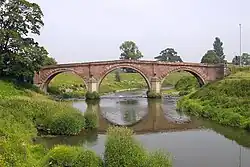Llandrinio Bridge
Llandrinio Bridge, Llandrinio, Powys, Wales, is a road bridge over the River Severn. Constructed between 1769 and 1775, the bridge is attributed to John Gwynn of Shrewsbury, a noted local architect who designed a number of crossings over the Severn, as well as Magdalen Bridge in Oxford. The bridge is also the site of defensive structures dating to World War II, including a pillbox disguised as an agricultural cowshed and Dragon's teeth tank traps at its northern end. The bridge is a Grade I listed structure and a Scheduled monument.
Llandrinio Pont Llandrinio Bridge in Wales | |
|---|---|
 | |
| Coordinates | 52.7459°N 3.0407°W |
| Carries | Road traffic |
| Crosses | River Severn |
| Locale | Llandrinio, Powys, Wales |
| Characteristics | |
| Material | Old Red Sandstone |
| Total length | 45.00 m (147.64 ft) |
| Width | 3.75 m (12.3 ft) |
| No. of spans | 3 |
| Piers in water | 2 |
| History | |
| Designer | John Gwynn |
| Construction start | 1769 |
| Construction end | 1775 |
Listed Building – Grade I | |
| Official name | Llandrinio Bridge |
| Designated | 26 October 1953 |
| Reference no. | 7666 |
| Official name | Llandrinio Bridge |
| Designated | 26 October 1953 |
| Reference no. | MG046 |
| Location | |
History and description
Archdeacon Thomas, in his History of the Parish of Llandrinio published in 1895, suggested that the site of Llandrinio Bridge represented an ancient crossing, and identified a reference to a medieval ferry in a charter of 1309.[1] The present bridge was built between 1769 and 1775, almost certainly to the designs of John Gwynn.[lower-alpha 1][2] Gwynn, a native of Shrewsbury, designed a number of crossings over the River Severn, including the English Bridge in his home town,[4] and Atcham Bridge in Shropshire.[5] He also worked in Oxford, designing the Covered Market[6] and Magdalen Bridge.[7]
At the outbreak of World War II, plans were made for the defence of Britain in the event of a German invasion. In the west, a defensive line, Western Command Stop Line No.1, followed the line of the Severn from Tewkesbury to Shrewsbury.[8] The line crossed the river at Llandrinio, and the bridge was fortified with a pillbox disguised as an agricultural shed and Dragon's teeth tank traps at its northern end.[9]
The Severn at Llandrinio is susceptible to flooding, which can lead to frequent closure of the bridge.[10][11][12] In 2015, particularly severe flooding led to fears that the bridge was at risk of collapse.[13] Subsequent investigations showed that several of the bridge's keystones had been removed by the floodwaters and a major programme of structural repair was required.[14]
Llandrinio Bridge is constructed of pink sandstone. Three arches span the river at a length of 45 metres.[15] Scourfield and Haslam, in their Powys volume of the Pevsner Buildings of Wales, describe Llandrinio as a "humped narrow roadway, yet a most graceful line when seen from the [river] bank."[2] The bridge is a Grade I listed structure and a Scheduled monument.[16][17]
Notes
References
- "Llandrinio" (PDF). Clwyd Powys Archaeological Trust. Retrieved 27 March 2021.
- Scourfield & Haslam 2013, p. 141.
- Cadw. "Llandrinio Bridge (Grade I) (7666)". National Historic Assets of Wales. Retrieved 27 March 2021.
- Historic England. "English Bridge (Grade II*) (1271479)". National Heritage List for England. Retrieved 27 March 2021.
- Historic England. "Atcham Bridge (Grade II*) (1176588)". National Heritage List for England. Retrieved 27 March 2021.
- Historic England. "The Covered Market, Oxford (Grade II) (1380159)". National Heritage List for England. Retrieved 27 March 2021.
- Historic England. "Magdalen Bridge (Grade II*) (1369360)". National Heritage List for England. Retrieved 27 March 2021.
- "Defence of Britain Archive - Llandrinio Pillbox". Council for British Archaeology. 1 July 1995.
- "Pill Box, Llandrinio (270336)". Coflein. RCAHMW. Retrieved 29 September 2021.
- "Severn at Llandrinio". River Levels UK. Retrieved 27 March 2021.
- "Severn at Llandrinio". FloodAssist. Retrieved 27 March 2021.
- Knight, Nick (17 March 2019). "Flooding problems on Llandrinio Bridge on the B4393". Powys County Times.
- "Llandrinio Bridge in Powys closed over collapse fear". BBC News. 1 December 2015.
- Doman, Robert (9 December 2015). "Ancient Llandrinio Bridge closed off due to 'major structural damage'". Oswestry & Border Counties Advertiser.
- "Llandrinio Bridge (24234)". Coflein. RCAHMW. Retrieved 29 September 2021.
- Cadw. "Llandrinio Bridge (Grade I) (7666)". National Historic Assets of Wales. Retrieved 27 March 2021.
- "Llandrinio Bridge". Scheduled Monuments UK. Retrieved 27 March 2021.
Sources
- Scourfield, Robert; Richard, Haslam (2013). Powys: Montgomeryshire, Radnorshire and Breconshire. The Buildings of Wales. New Haven and London: Yale University Press. ISBN 978-0-300-18508-9. OCLC 935421607.